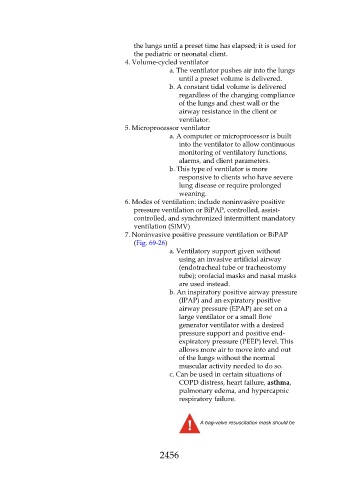Page 2456 - Saunders Comprehensive Review For NCLEX-RN
P. 2456
the lungs until a preset time has elapsed; it is used for
the pediatric or neonatal client.
4. Volume-cycled ventilator
a. The ventilator pushes air into the lungs
until a preset volume is delivered.
b. A constant tidal volume is delivered
regardless of the changing compliance
of the lungs and chest wall or the
airway resistance in the client or
ventilator.
5. Microprocessor ventilator
a. A computer or microprocessor is built
into the ventilator to allow continuous
monitoring of ventilatory functions,
alarms, and client parameters.
b. This type of ventilator is more
responsive to clients who have severe
lung disease or require prolonged
weaning.
6. Modes of ventilation: include noninvasive positive
pressure ventilation or BiPAP, controlled, assist-
controlled, and synchronized intermittent mandatory
ventilation (SIMV)
7. Noninvasive positive pressure ventilation or BiPAP
(Fig. 69-26)
a. Ventilatory support given without
using an invasive artificial airway
(endotracheal tube or tracheostomy
tube); orofacial masks and nasal masks
are used instead.
b. An inspiratory positive airway pressure
(IPAP) and an expiratory positive
airway pressure (EPAP) are set on a
large ventilator or a small flow
generator ventilator with a desired
pressure support and positive end-
expiratory pressure (PEEP) level. This
allows more air to move into and out
of the lungs without the normal
muscular activity needed to do so.
c. Can be used in certain situations of
COPD distress, heart failure, asthma,
pulmonary edema, and hypercapnic
respiratory failure.
A bag-valve resuscitation mask should be
2456

